We are now finally starting to see the surface of asteroid Ryugu. But at the beginning of June, Ryugu was just a bright dot on our Star Tracker. We asked our Project Members and professional creators what they thought Ryugu might look and these are the suggestions they offered. How close were we?
(This article is a translation of the original Japanese version published on June 5, 2018).
The exact shape and structure of Ryugu is unknown, as the asteroid has never been seen in detail. We therefore asked everyone to imagine what Ryugu might look like for our "Imaging Ryugu" competition. For this contest, 18 locations within Japan and 7 from overseas became nodes to gather artwork of Ryugu showing what people have imagined. Many excellent contributions have already been gathered and once we have seen Ryugu in detail, these will be introduced by the Hayabusa2 Project. Each node is also presenting works they have received, so please do explore their sites.
But before we arrive, let's take a look at how Ryugu is imagined by professional creators and members of the Hayabusa2 Project team.
We can start by asking what the Director General of JAXA's Institute of Space and Astronautical Sciences (and the previous Project Manager of Hayabusa2) thinks asteroid Ryugu is going to look like?
(by Hitoshi Kuninaka)Now let's look at a Ryugu imagined by professional creators, followed by a comment from our spacecraft, Haya2-kun!
■1. LIVE Company Ltd. / HAYABUSA2 - RETURN TO THE UNIVERSE, Director Hiromitsu Kohsaka.
(by Hiromitsu Kohsaka)-
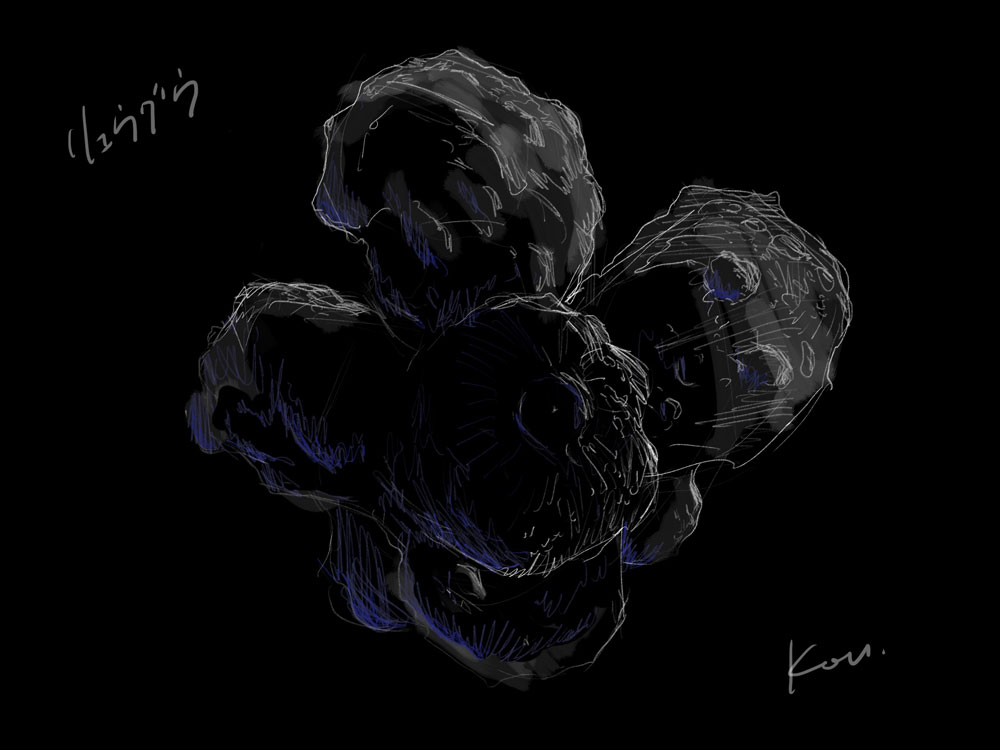 [Enlargement]
[Enlargement]
I tried to draw the worst possible pattern, so that even when the asteroid is rotated, there is no change in the light intensity. I pray that the actual Ryugu is not like this (haha)! If we assume this imaginary picture is accurate, then nothing can scare us (haha)!
Haya2-kun says...
It will be dreadful if I enter one of the gaps! I must be careful when approaching...
■2. Artist Akihiro Ikeshita
(by Akihiro Ikeshita)-
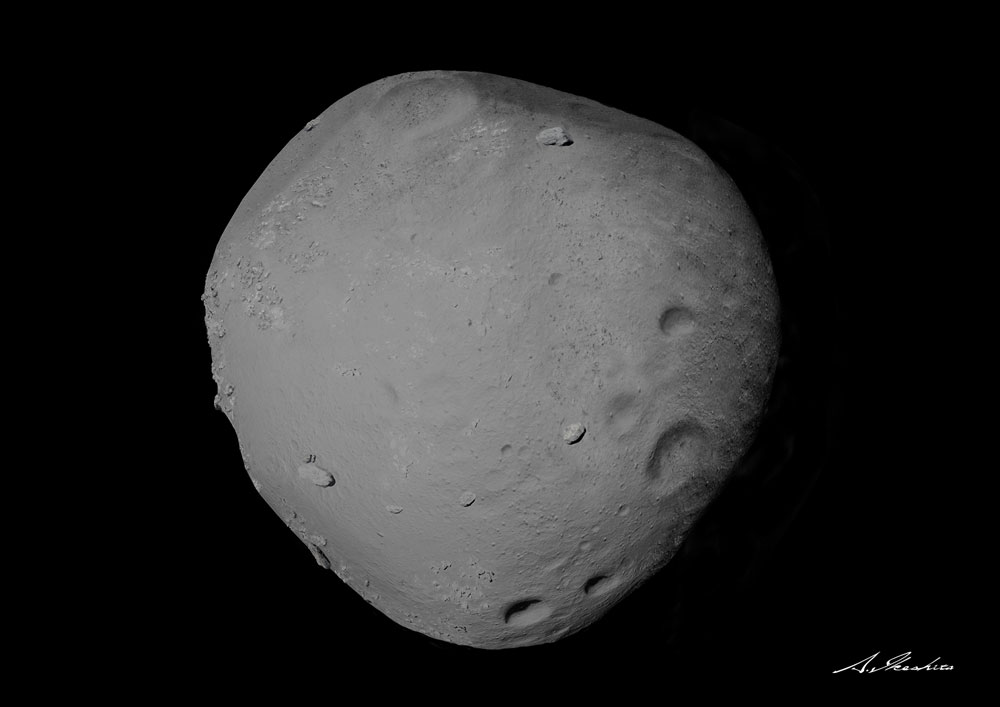 [Enlargement]
[Enlargement]
This took me a while because I drew freehand in Photoshop, but I think Ryugu could be something like this. As this turned out rather uninteresting, I'll be happy if Ryugu betrays this in a good way like for Itokawa. After all, I expect a surprise!
Haya2-kun says...
If this is the case, it looks like it will be possible to land in many places...
■3. Photographer, 133 Amami Tourism Ambassador and healthy gourmet cuisine researcher, Ms Junko Yamanaka
(by Junko Yamanaka)-
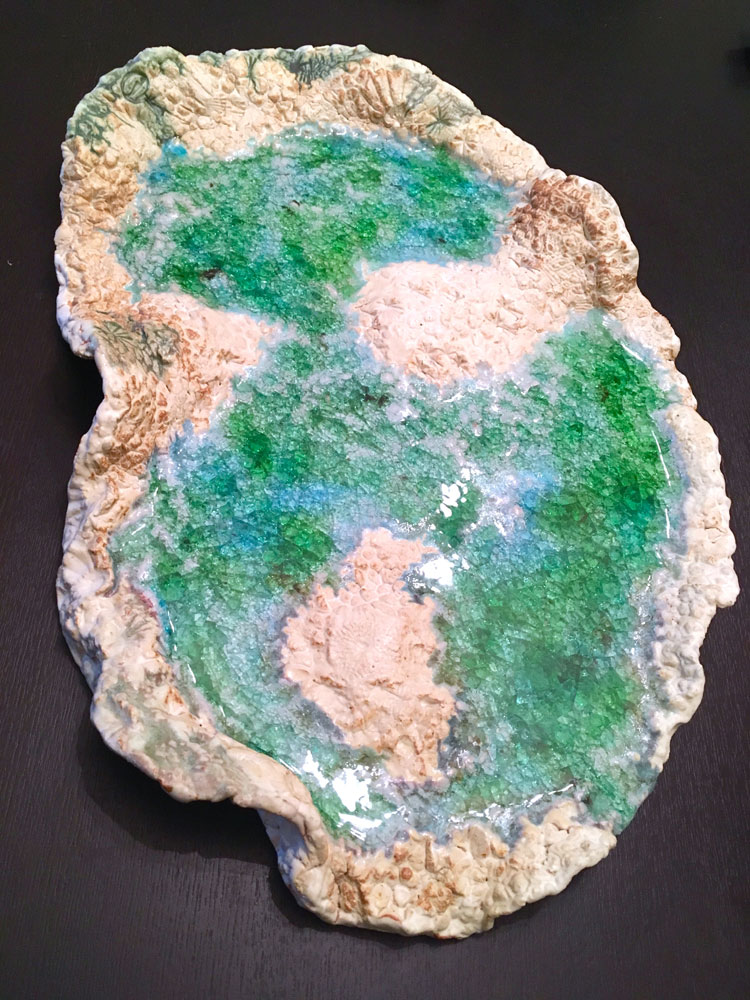 [Enlargement]
[Enlargement]
A coral beach colors the coast of Amami Oshima... from this coral beach, I received a piece of life... on the coral surface, shapes formed an image of the ruggedness of another rich planet like our blue and beautiful Earth... I am certain I can find it in my dreams... so I created it out of pottery. Amami is the gods' island and is called "Ryugu Castle" by many people. Beyond the sea and the sky, I believe there is the planet Neriyakana (said to be the paradise of a good harvest).
Haya2-kun says...
If this is the case, there will be plenty of organic matter...
Next, let's ask the Hayabusa2 Project Members how they imagine Ryugu. From serious to entertaining imaginings, these are what they suggested:
■4. Yuichi Tsuda, Project Manager
(by Yuichi Tsuda)-
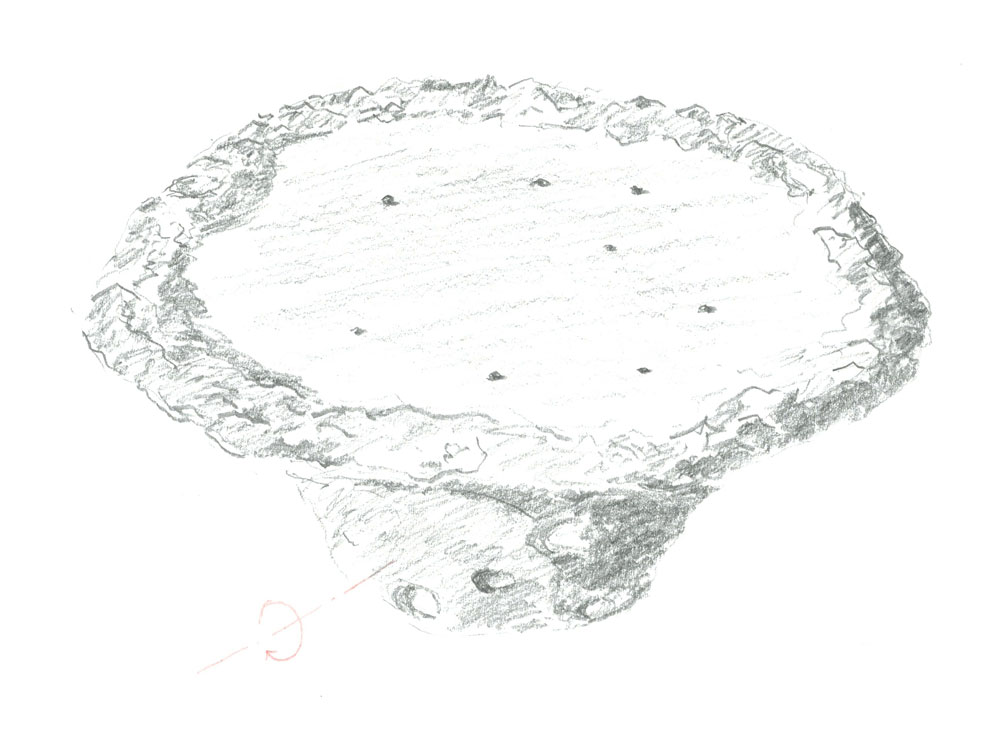
We can land on this shape of asteroid very safely, although it has a lot of surprises:
This is a "straw hat"-type.
Vast plain of sandy land, abundant in water-rich minerals.
Enough pebbles to act as landmarks on the flat landscape.
A single spin-axis, but below the maximum moment-of-inertia [to avoid break-up].
Haya2-kun says...
Truly, Project Manager Tsuda, this shape will allow me to land safely. The science is also perfect! Maybe I can relax on the surface of Ryugu... Eh, would that be bad?
■5. Sei'ichiro Watanabe, Project Scientist
(by Sei-ichiro Watanabe)-
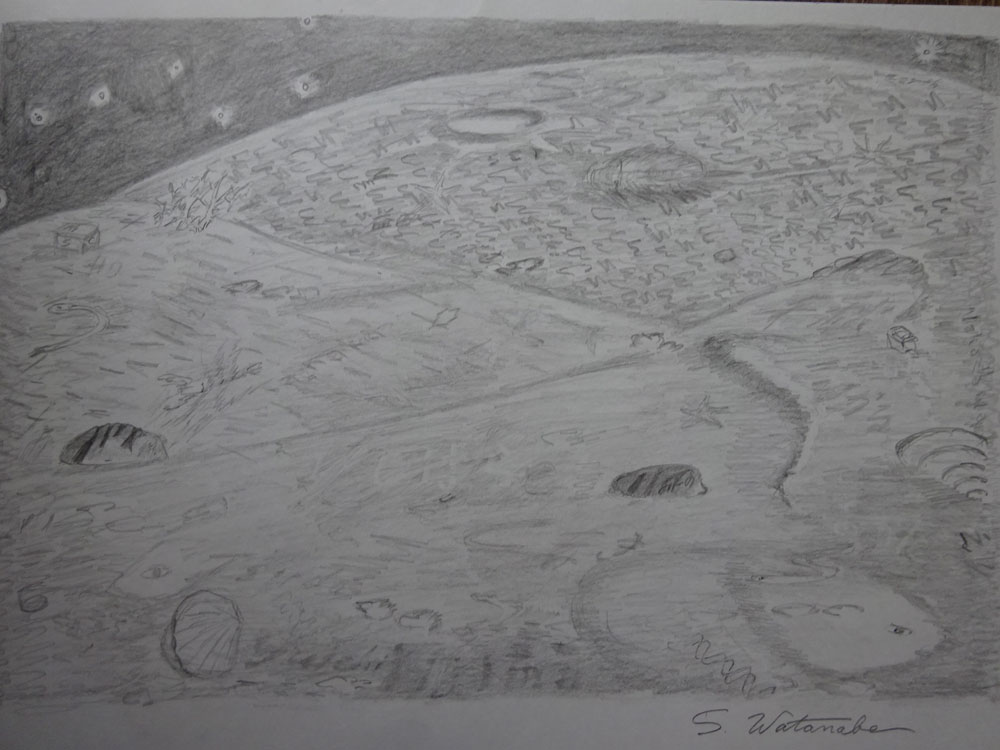 [Enlargement]
[Enlargement]
Because Ryugu is beyond our imagination, I expect the true shape to stir-up new imaginations!
Haya2-kun says...
I may also land safely on Professor Watanabe's asteroid. But when you look closely it seems there are various living creatures, so where should I land?
■6. Satoru Nakazawa, Sub-Manager
(by Satoru Nakazawa)-
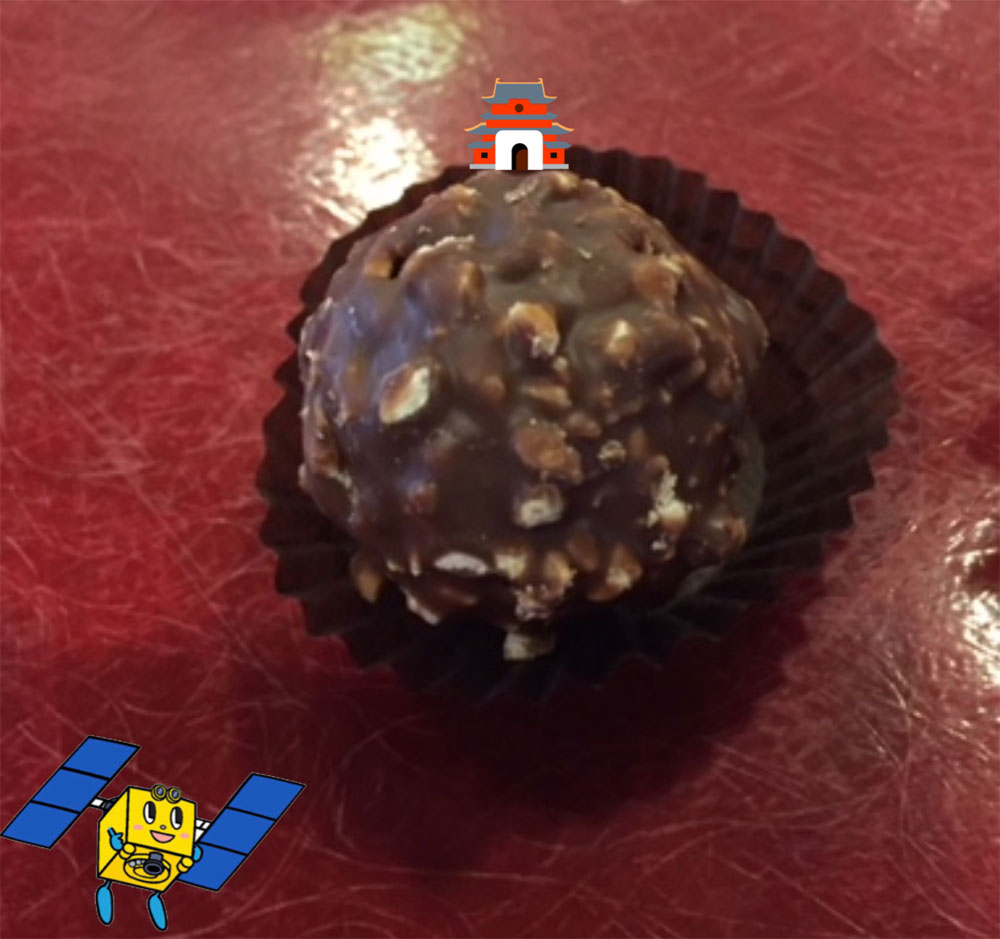
When I found this in the canteen at ESTEC [One of the European Space Agency's centers in the Netherlands], I saw Ryugu. If the asteroid is like this, would touchdown be possible?!
-
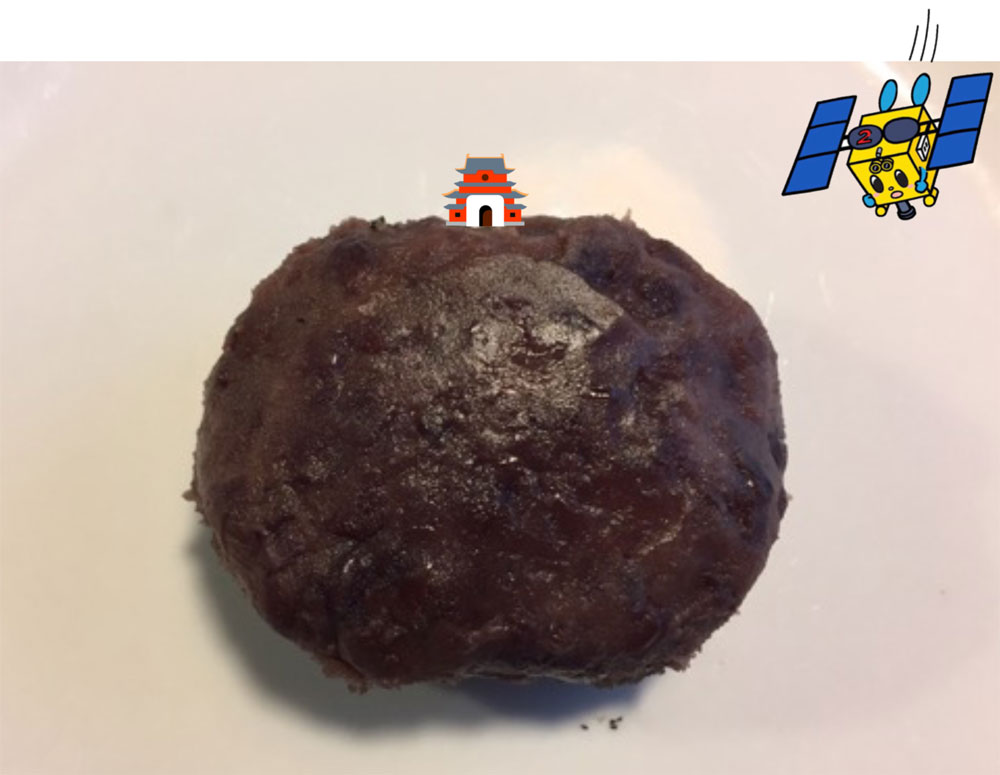
I saw this in a supermarket and it looked like Ryugu. Is its reflectivity too high?
-
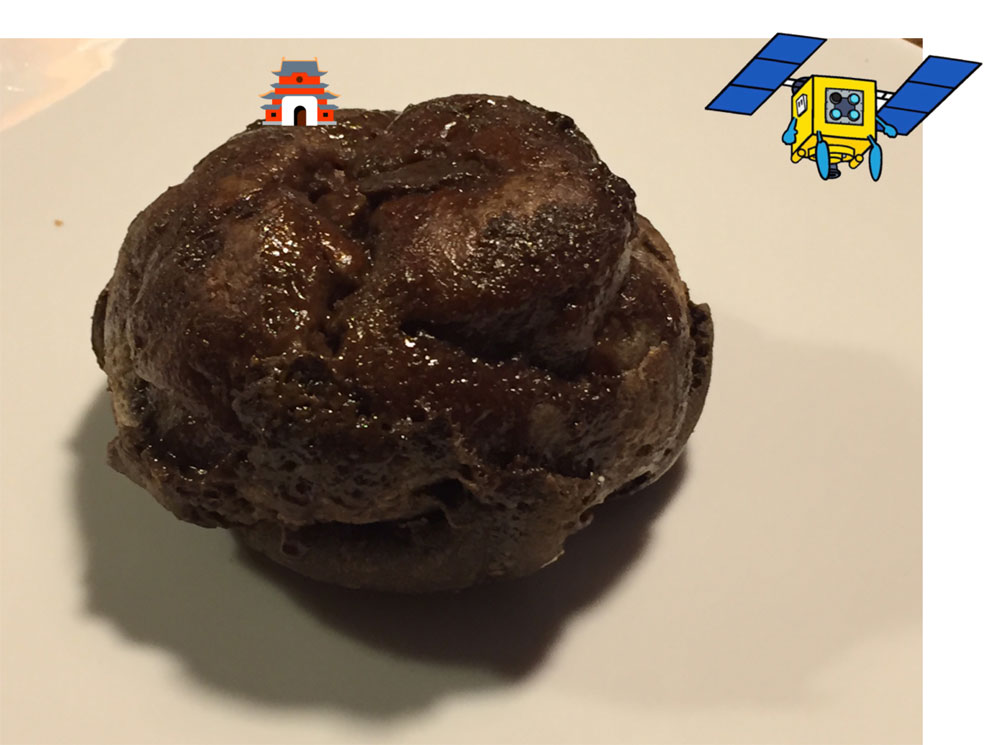
A Karinto puffcream. All the black and round things have come to look like Ryugu to me!
Haya2-kun says...
Mmm, everything looks delicious... even if they are all black and round, they are all sweet.
■7. Yuya Mimasu, responsible for the AOCS (Altitude and Orbit Control Subsystem).
(by Yuya Mimasu)-
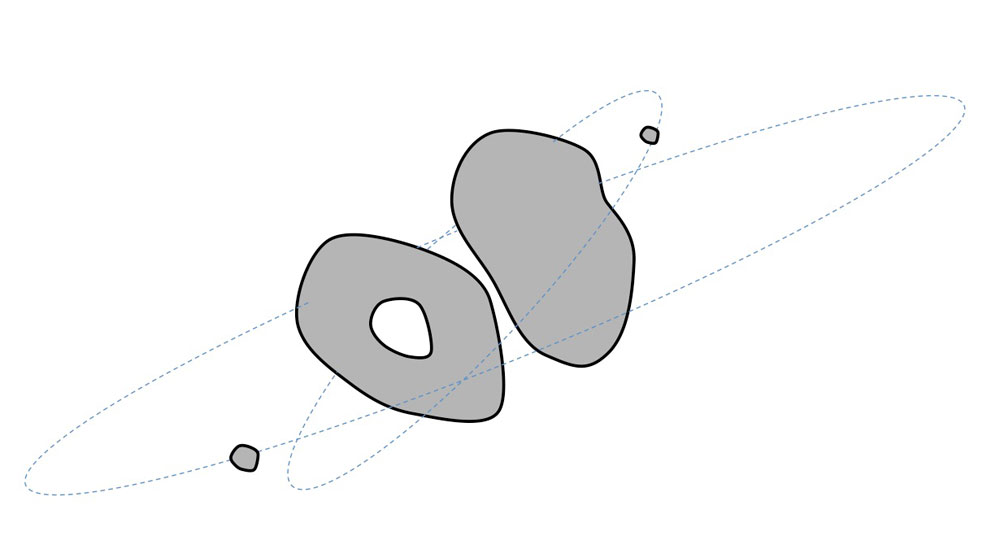
This estimated asteroid shape is based on hope and wishful observations of the person in charge of the AOCS! I think it would be definitely fun (for operations) if it were like this.
Haya2-kun says...
Ahh, this is extremely difficult to approach. I have to avoid hitting two small satellites around a perforated contact binary! So, what is the safe orbit that will pass through this hole?
■8. Tomohiro Yamaguchi, responsible for systems
(by Tomohiro Yamaguchi)-
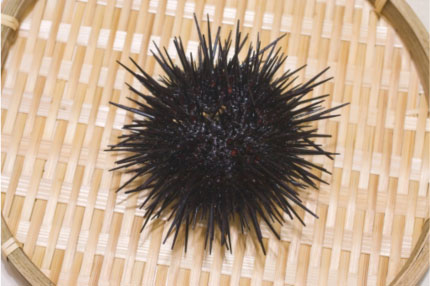
I assumed the worst case.
Haya2-kun says...
This is definitely the worst! Before I get close to landing, I am likely to be pierced by a prickle during the approach. Project Manager Tsuda also said "this is terrible". But he added, "when you open the inside, there should be fascinating things!"
■9. Takaneo Saiki, Project Engineer
(by Takanao Saiki)-
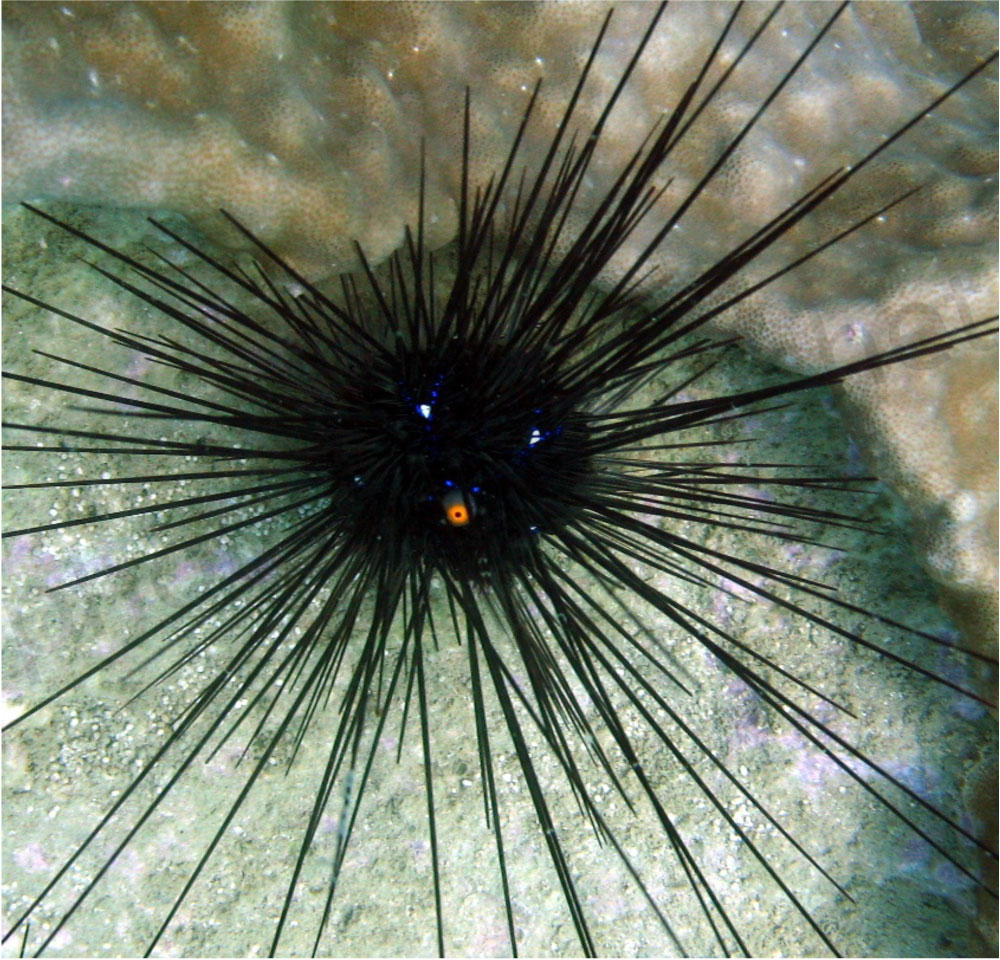
This is an even worse assumption. Or it is Ryugu after driving in the SCI.
-
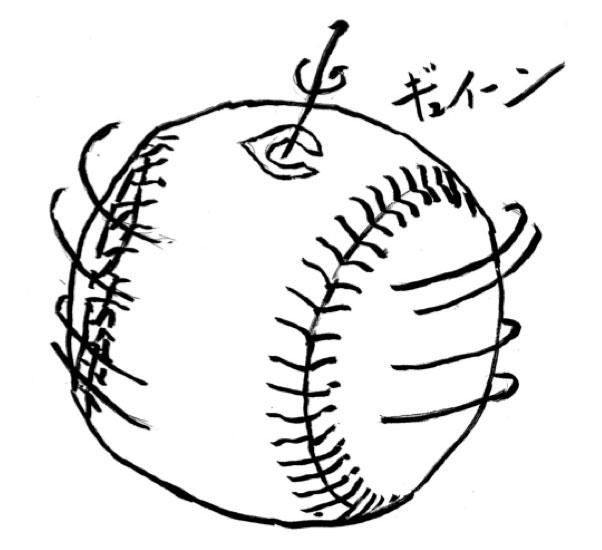
A two-seam fastball. With a spin too fast to touchdown!
Haya2-kun says...
This is even worse than the worst! I guess Ryugu became angry when I used the SCI [impactor]. I wonder if there are asteroids like baseballs. But I cannot land on this either, the rotation is too fast. Go, Carps! [The Hiroshima Toyo Carp are a professional baseball team in Japan].
[SCI is the Small Carry-on Impactor, which will be used for making an artificial crater on the asteroid surface.]
■10. The brother of Satoshi Hosoda, responsible for the ion engines
(by Satoshi Hosoda)-
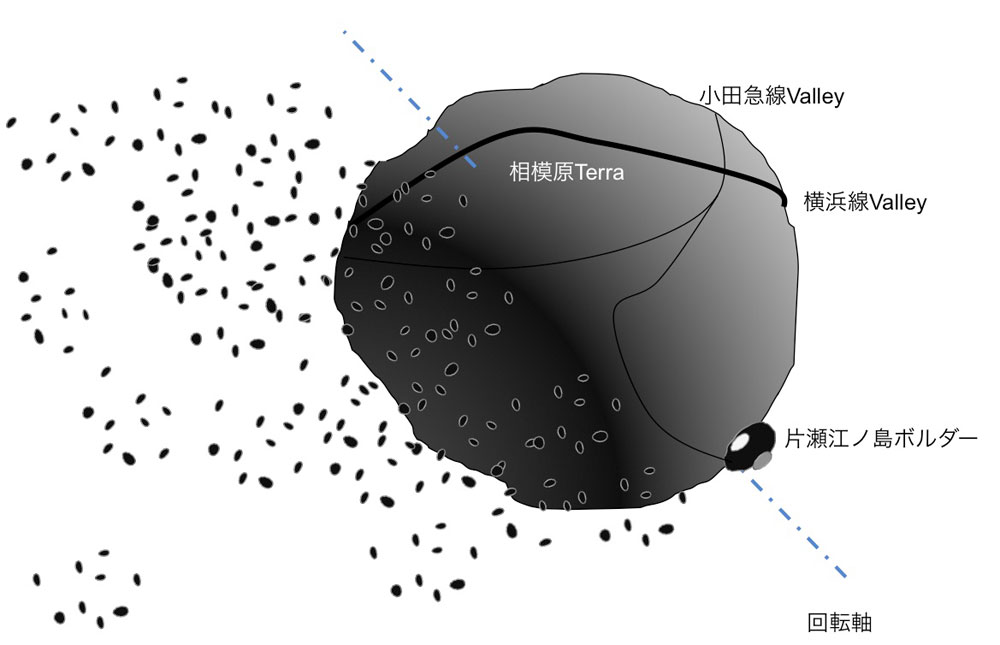
Another rubble pile celestial body! The seams look like railway lines. There is a mysterious class of asteroid regolith that floats in an electric field at the daylight boundary. Because the grains are charged by the photoelectric effect, it sticks to the spacecraft if the plasma from the ion engine is not released!
Haya2-kun says...
Mysterious regoliths, how scary~. But I'm protected by the ion engine. Good! But, I'm a bit worried that there will not be enough xenon. So... where is Fuchinobe?! [Fuchinobe is where the Hayabusa2 Project team are located.]
■11. Kanako Sakamoto (with help from her 2 year old daughter), responsible for sampling
(by Kanako Sakamoto)-
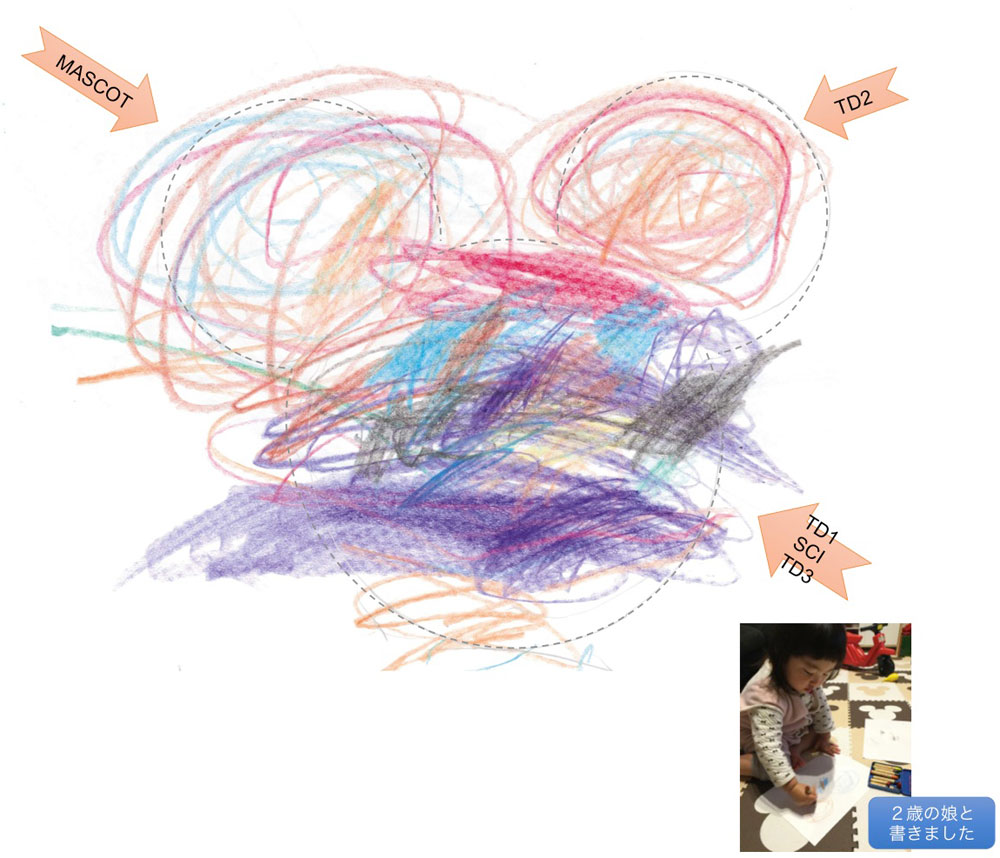
What a Ryugu -- the shape seems to be filled with dreams! The surface of Ryugu is not rugged like Itokawa, but overall surface conditions are rough. The color is also like a carbonaceous chondrite; black and dark. The scene seems to be covered with rice grains (black rice) and wheat chocolate. When the sampler horn hits, it will no doubt squish and enter the surface and stab out a sample! Like when weighing rice with a measuring cup, a lot of the sample will be caught on the horn tip.
Haya2-kun says...
This is a splendid Ryugu. It looks fun! If I take a lot of samples here then I will end up with a full stomach.
■12. Tatsuaki Okada, responsible for the TIR (Thermal Infrared Imager)
(by Tatsuaki Okada)-
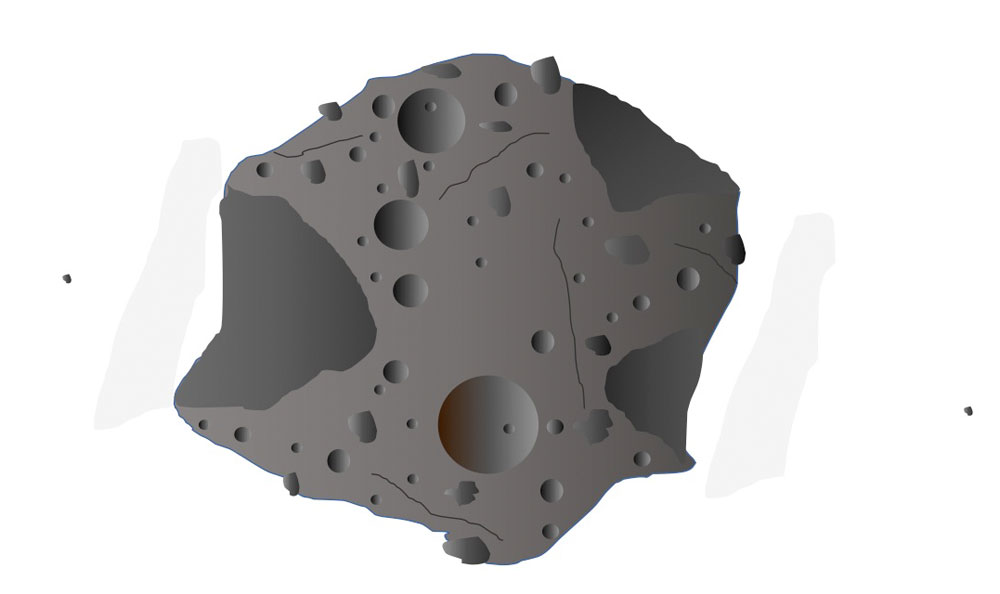
- There are huge holes from craters.
- The number of craters is not saturated; large and small craters can be seen globally.
- The inside of the craters have slightly different colors and spectra to the surface layer.
- There are boulders in large and small sizes on all over the surface.
- There are plains with fewer boulders and craters (with a lot of gravel).
- Traces of cracks exist.
- There are short-lived satellites (floating rocks)
- There is also floating dust.
Haya2-kun says...
Quite a realistic imagination... How come the rock floats? I have to be careful to avoid bumping into this!
■13. Kent Yoshikawa, responsible for the AOCS
(by Kent Yoshikawa)-
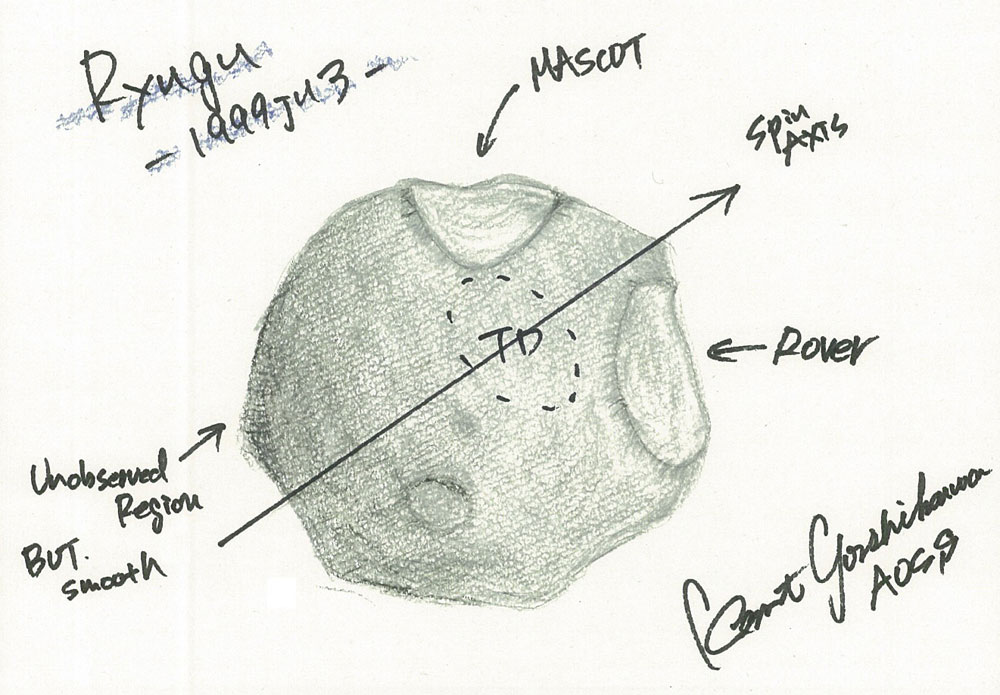
I imagined (and hope) an asteroid that is convenient for operations such as touchdown and rover deployment.
Haya2-kun says...
Hey, this seems to be safe to land. We can also explore safely with MASCOT and the Minerva-II rovers. Project members have been imagining only difficult Ryugus, but this one is OK!
■14. Atsushi Fujii, responsible for ground systems
(by Atsushi Fujii)-
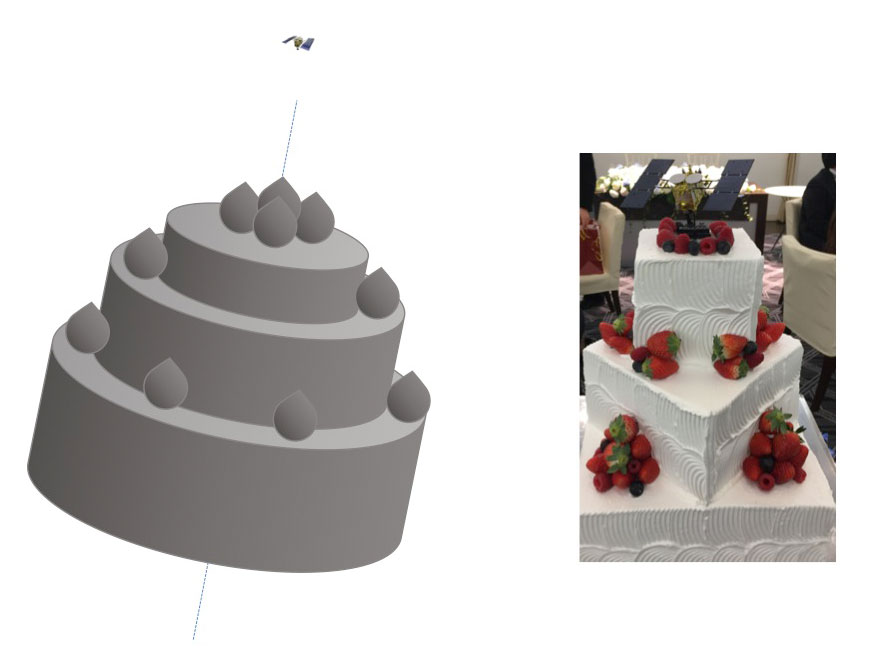
Cake-type!
Haya2-kun says...
Haha, such an asteroid would be fun! I wonder where to land...
■15. Go Ono, responsible for the AOCS
(by Go Ono)-
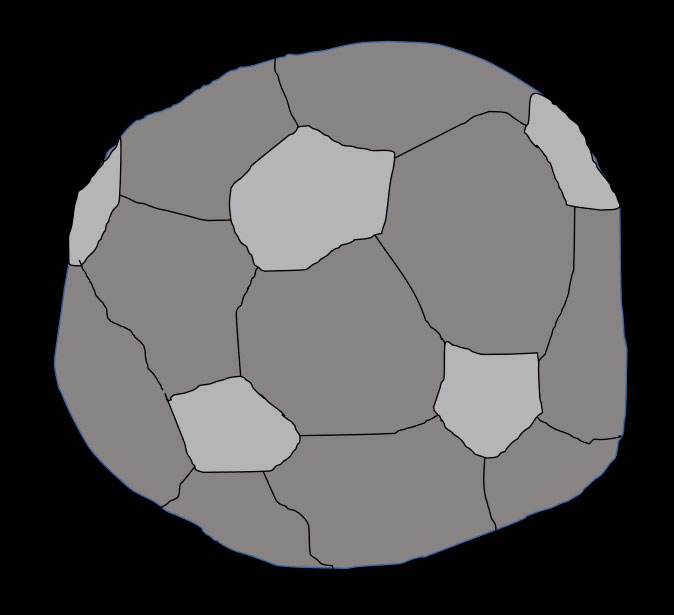
Soccer ball...? It is only a goal!
Haya2-kun says...
Goooooal! My first goal is Ryugu. My next goal is returning to Earth.
■16. Stefania Soldini, responsible for orbit design
(by Stefania Soldini)-
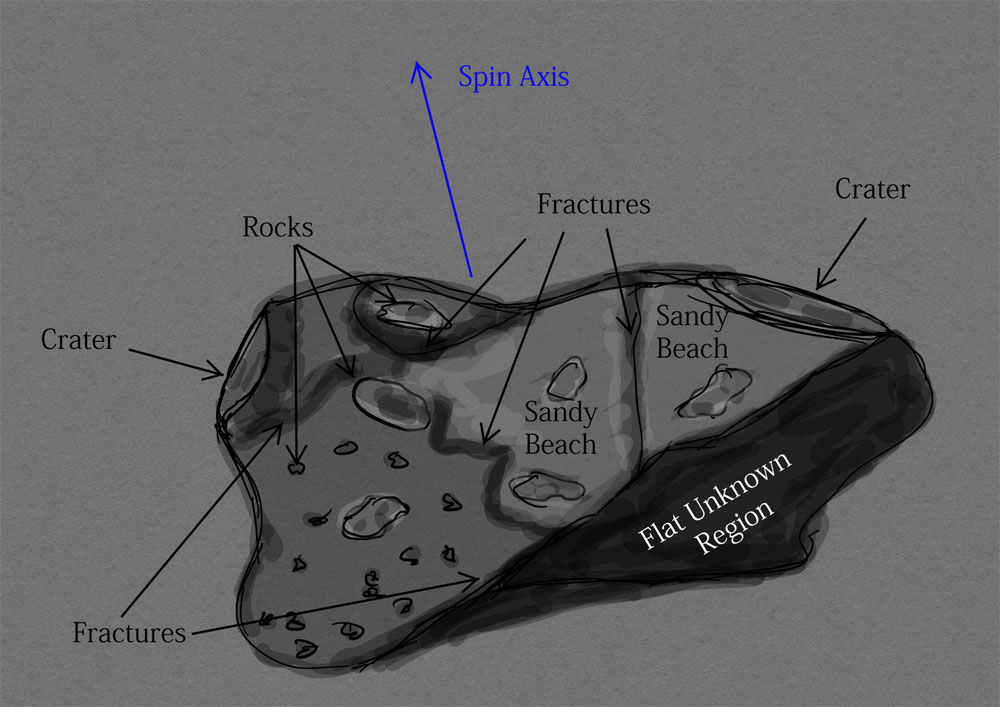
My vision of Ryugu is inspired by Christmas "candy coal" or “かいたんあめ”. A porous asteroid with several fractures easy to break, sandy "beaches", couple of craters and rocks. Finally, an unexpected flat and smooth region is present to puzzle scientists on its formation! Surely, Ryugu's sample will not taste like sugar candy but delightful discoveries are going to be revealed by Hayabusa2 Mission!
Haya2-kun says...
Buon giorno! What is candy coal? Is it handed out in Italy at Christmas time? There are many places I'd like to set down~
■17. Tadateru Takahashi, responsible for systems
(by Tadateru Takahashi)-
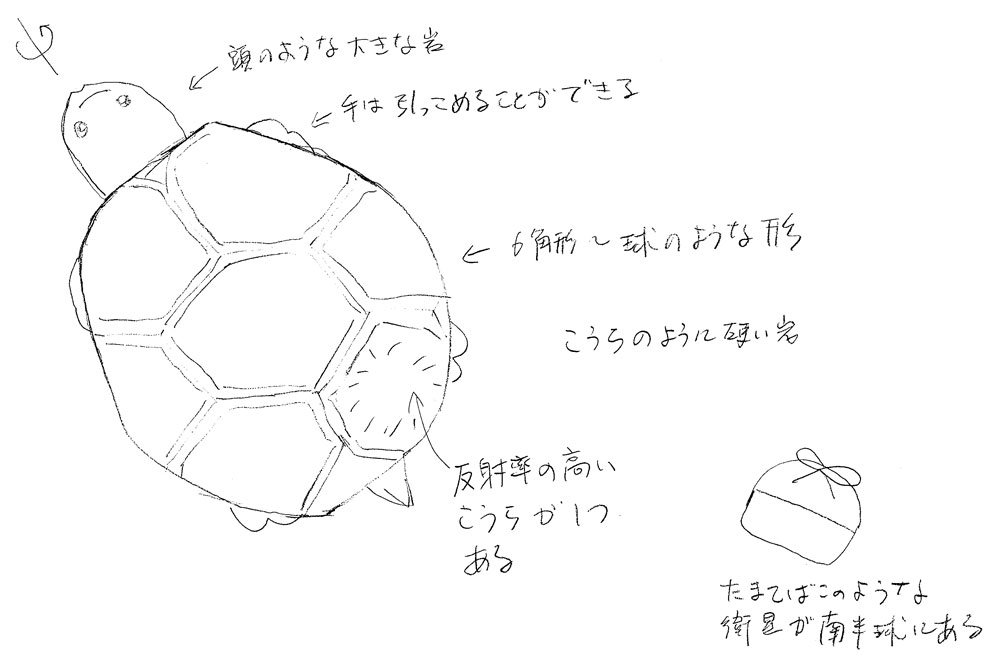
As Itokawa looked like a sea otter, I imagined what other fun creatures could be asteroids. I wanted to have a turtle carrying a treasure box on its back [this is from the Japanese folk tale of Urashima from which Ryugu takes its name. The treasure box contained the old age of Urashima as a smoke.]. However, it would be interesting if the asteroid had a satellite. So I tried a treasure chest-type moon.
Haya2-kun says...
This is just a turtle! Since the shell seems to be hard, the impactor may bounce back. I wonder what is on the treasure box-like moon. As I approach, would smoke come out and make me old?
■18. Kohei Kitazoto, responsible for NIRS3 (Near Infrared Spectrometer)
(by Kohei Kitazato)-
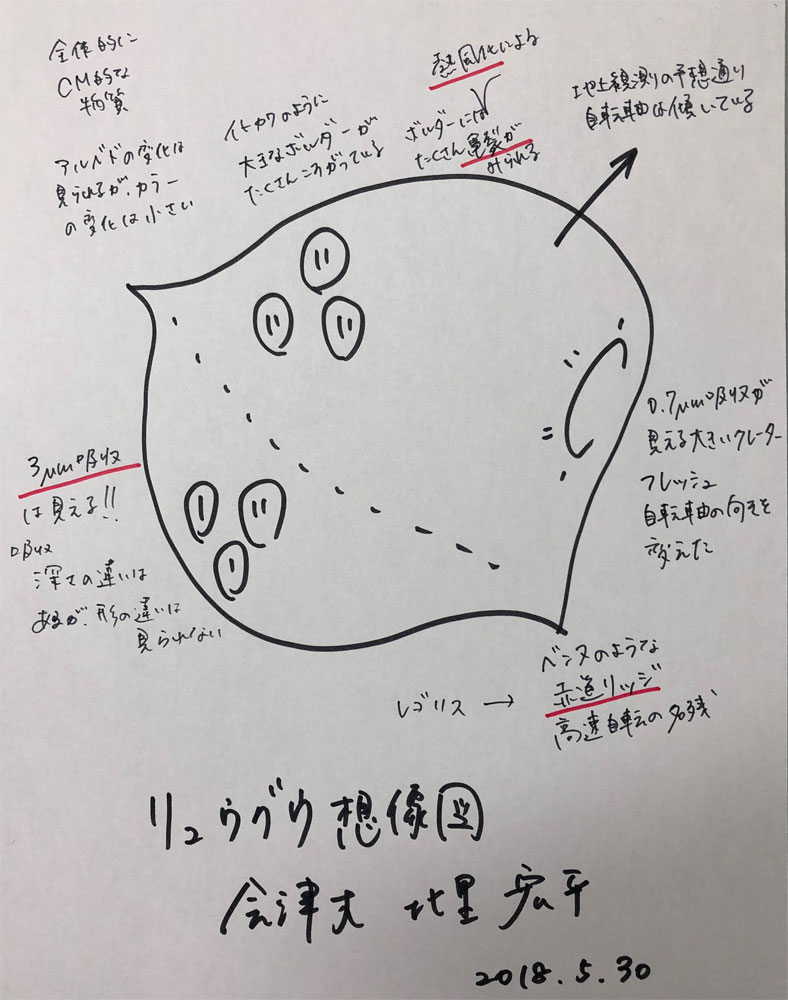 [Enlargement]
[Enlargement]
We went to win!
Haya2-kun says...
That is a detailed science forecast! Are you able to see absorption at 3 microns [indicating hydrated minerals]?
■19. Masahiko Hayakawa, responsible for science
(by Masahiko Hayakawa)-
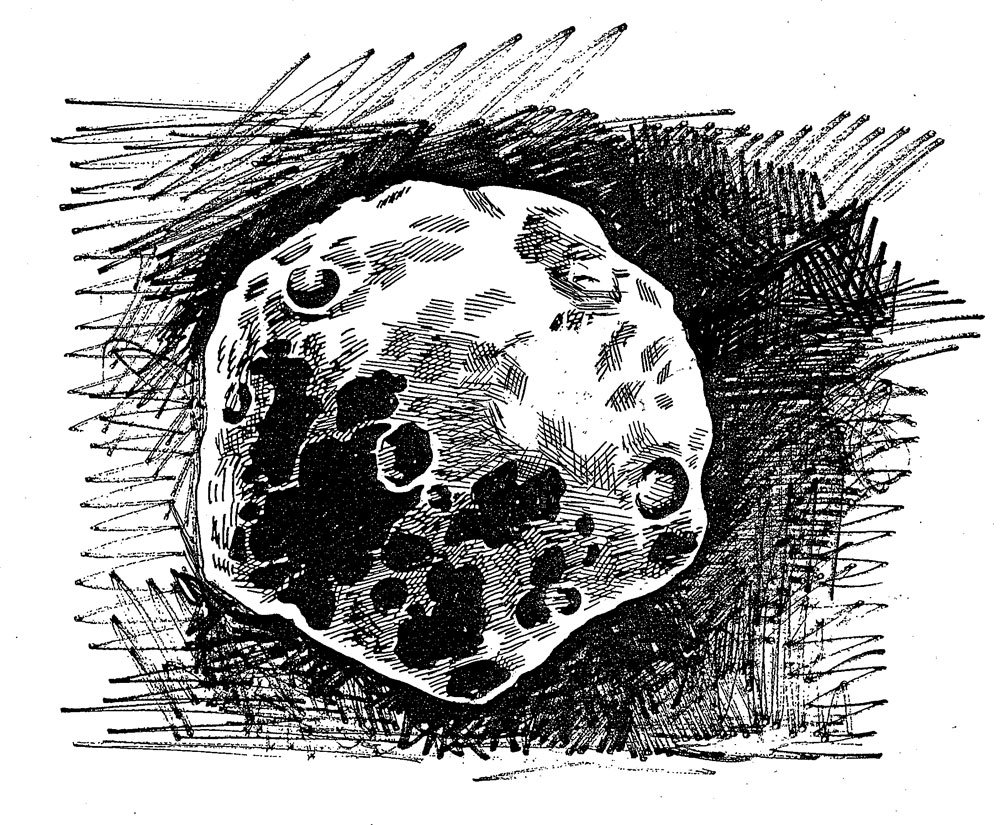
This picture is a C-type asteroid I imagined about 30 years ago.
※はやツー君コメント
Thirty years ago it was 1988. At that time, a probe had never approached an asteroid. Were you anticipating the Hayabusa2 mission even then?
■20. Hitoshi Ikeda, responsible for astro-dynamics
(by Hitoshi Ikeda)-
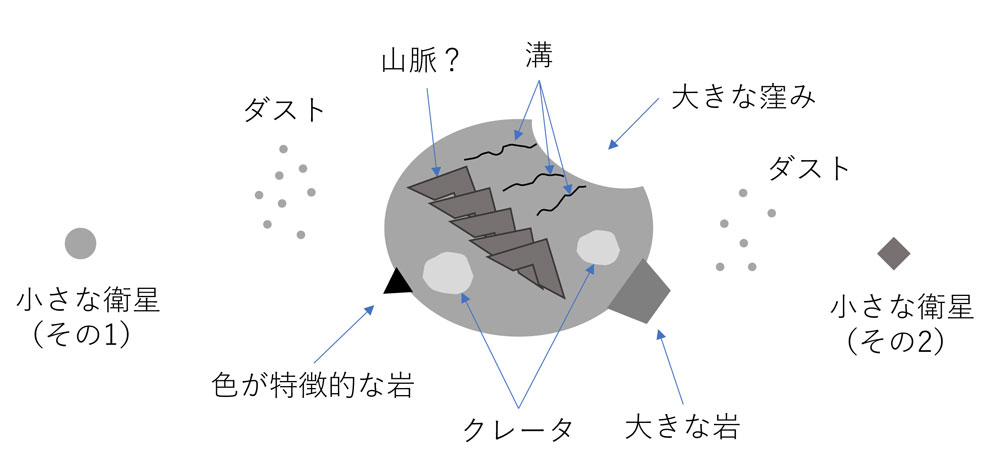
If there are satellites and dust, then the trajectory analysis seems like it would be fun! It is difficult to operate the spacecraft but...
Haya2-kun says...
There are many features~. The satellites and dusts means I must be careful during approach...
■21. Takahira Iwata, responsible for NIRS3
(by Takahiro Iwata)-
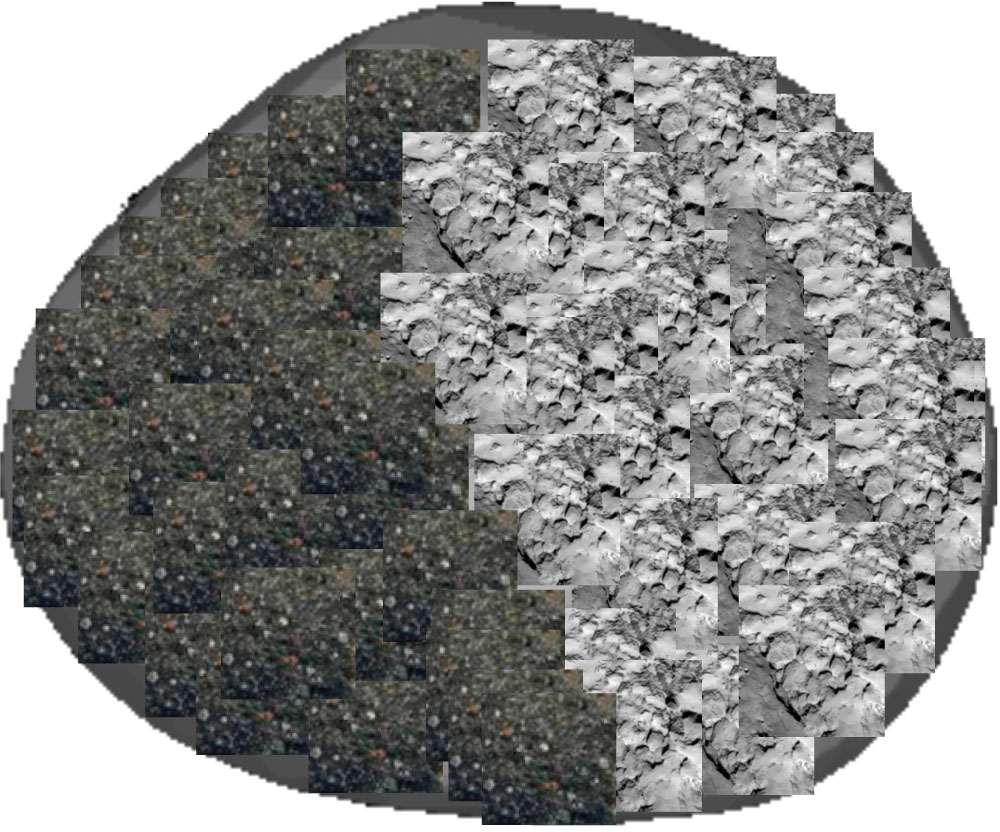
- The full appearance of Ryugu: dayside on the right and nightside on the left. The day and night boundary on a round object gives a somewhat distorted shape.
- Surface topology: Like the nucleus of comet Churyumov–Gerasimenko, there are intense irregularities that look like holes left after ice has evaporated. It may be a bit painful to find a safe place to land...
- Surface geology: Like C-type chondrites, the surface is covered with black carbonaceous minerals. In some places, there are also lighter-colored minerals.
I have imagined a very conservative view but I hope to be very wrong!
Haya2-kun says...
As expected from a scientist, the asteroid imagined is a C-type. I have to make sure the sampler horn is not caught in one of the holes...
■22. Yuto Takei, responsible for systems
(by Yuto Takei)-
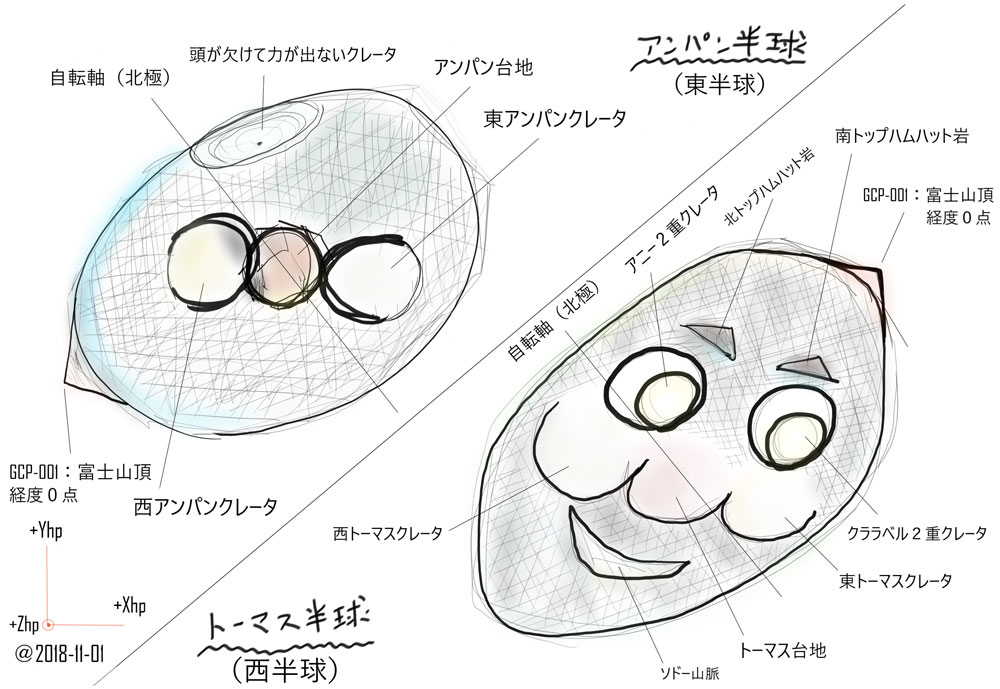 [Enlargement]
[Enlargement]
I wrote about how to see Ryugu from the Earth from November 1, 2018. Both the "Anpan" [A popular Japanese children's character] hemisphere and the "Thomas" hemisphere have a large plateau (a nose) between two craters that can be candidates for touchdown. With the predicted GCP-NAV decent accuracy, we can certainly touchdown! After the SCI operation, the asteroid may say "I lack my head and have no power" [A popular saying of Anpanman's, whose head is a beancake].
[GCP-NAV refers to the Ground Control Point Navigation, which is the image guidance system during decent operations.]
Haya2-kun says...
Haha, this is doubly-fun asteroid! Children will be pleased. But what is meant by "a crater that does not have power" or "an asteroid that do not have power"?
■23. Shogo Tachibana, responsible for sample analysis
(by Shogo Tachibana)-
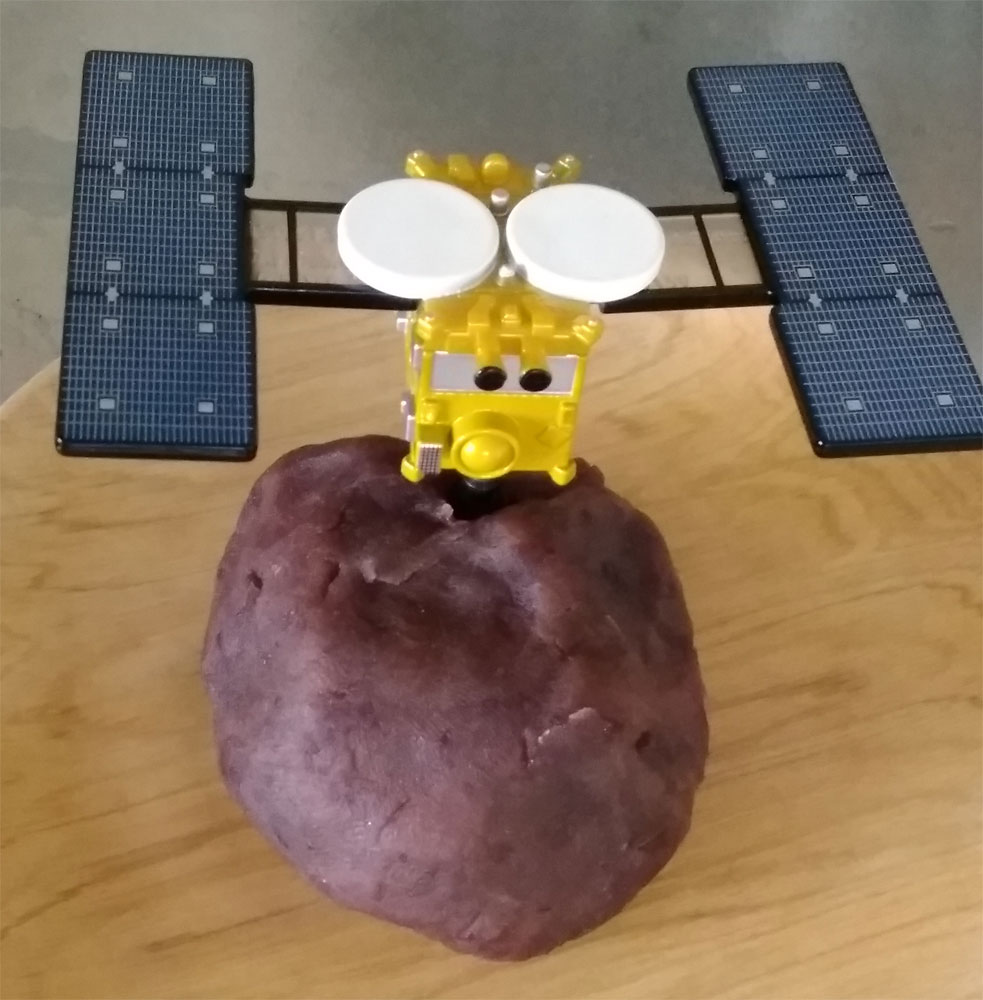
I'm hoping for lots of life-related organic matter. (Later on, I ate this and it was delicious)
Haya2-kun says...
This looks delicious! It is exactly a lump of organic matter! I wonder if the color will be like this...
■24. Jun'ichi Haruyama, responsible for science
(by Jun'ichi Haruyama)-
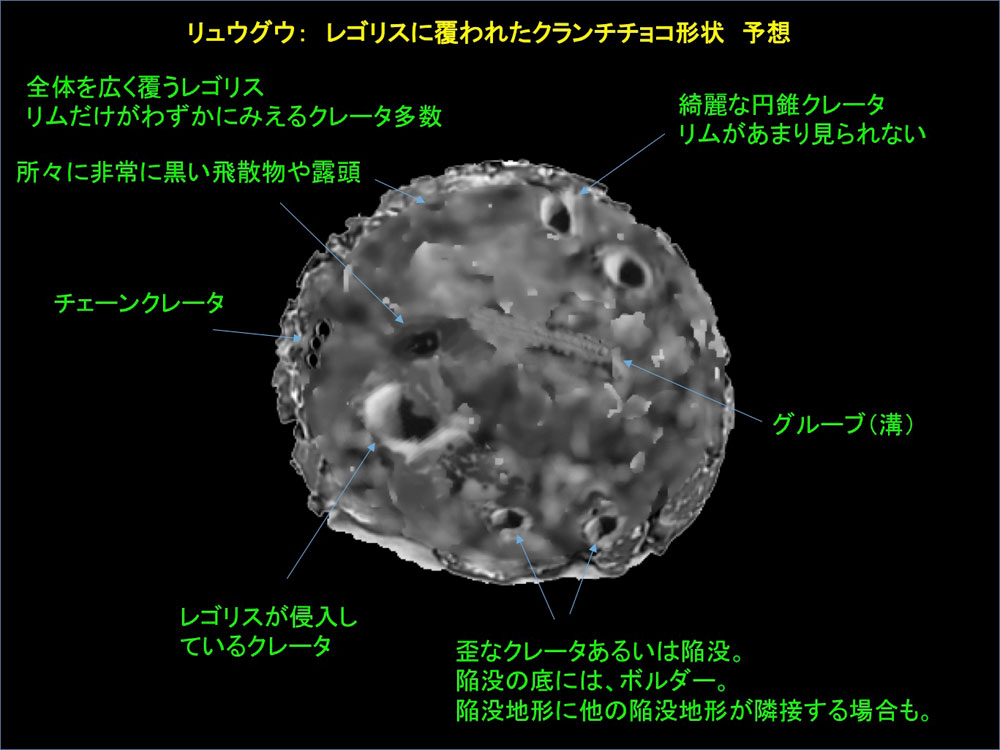 [Enlargement]
[Enlargement]
I wondered if it will be the Ferrero Rocher-type or chocolate crunch type, but I will bet on the latter.
Haya2-kun says...
Both choices seem delicious. Many people like sweets among the Hayabusa2 Project Members, but there's still a lot of imagination. Where would be good to land?
■25. Seiji Sugita, responsible for ONC (Optical Navigation Camera)
(by Seiji Sugita)-
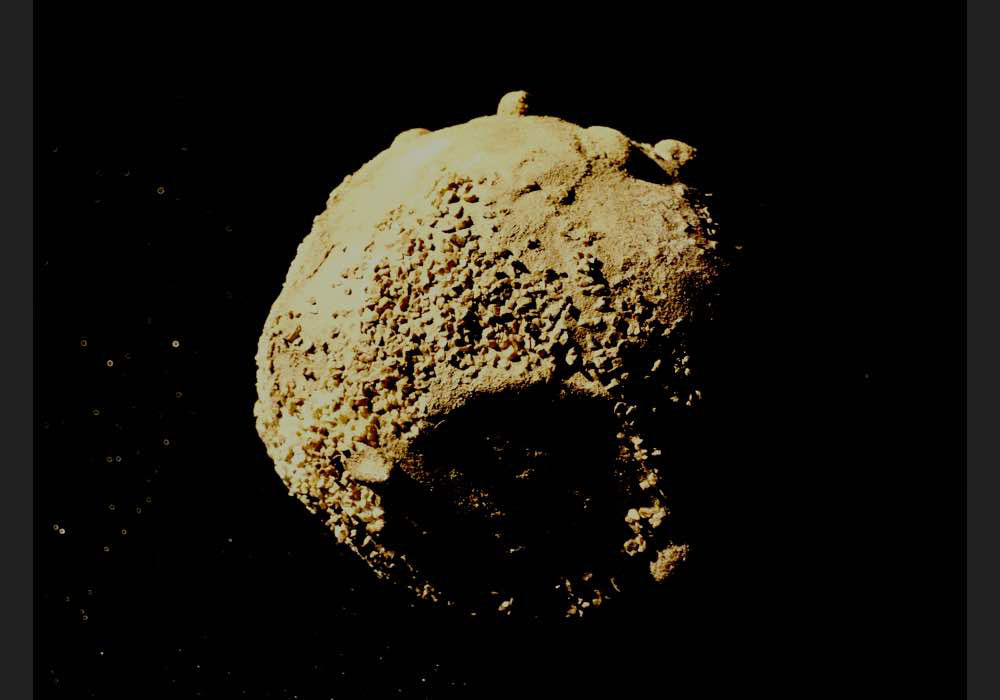
<アニメGIFへのリンク>
The colors are difficult to distinguish when you create and image in a space-like setting. But the north pole and south pole are brown and the equator is light brown - yellow in color. In addition, it seems like there is a light blue part within a wilderness of boulders. It would be tricky to land here, but there does seem to be lots of water. There is also a crater and boulders are spread about.
Haya2-kun says...
This seems real! As expected from the ONC team. I wonder where I should land. It looks difficult. I must trust the skills of the navigation team.
■26. University of Tokyo, postdocs and students in Professor Sugita's laboratory (Tanabe, Takagi, Sugimoto and Tatsumi).
(by Tanabe, Takagi, Sugimoto, and Tatsumi)-
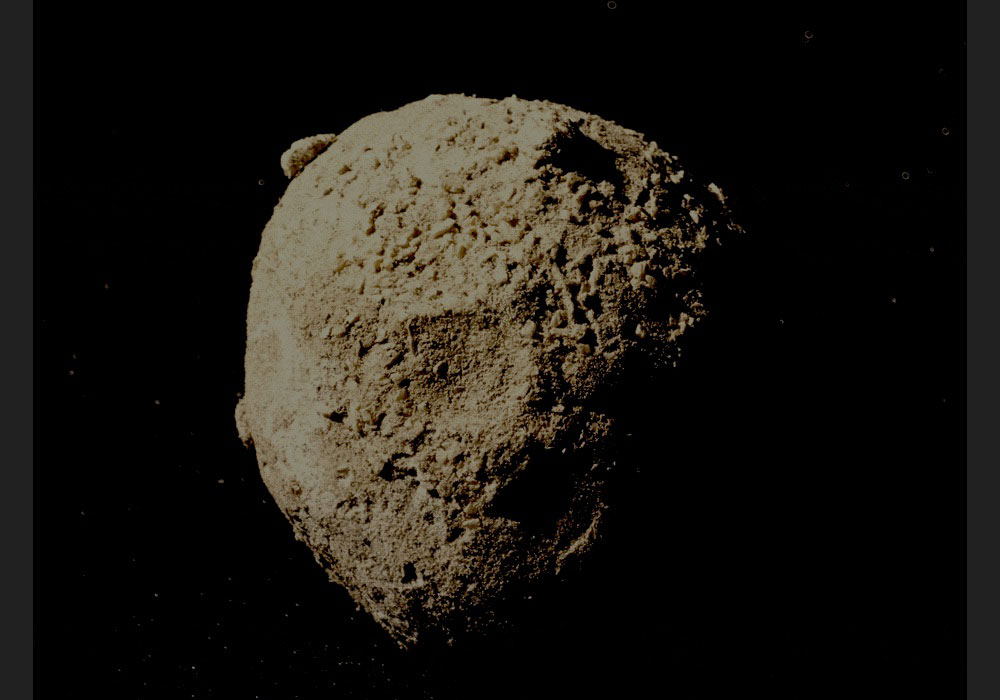
<アニメGIFへのリンク>
The overall shape looks like a slightly flattened sphere. Rocks from a few meters to a few 10s meters are widely scattered and shallow, relaxed craters can be seen in a number of places. There also seems to be different surface environments, such as linear features and relatively smooth places with few rocks. At mid-latitudes, there are places with fewer rocks that seem easy to land, but it also seems interesting to land in a crater.
Haya2-kun says...
This is so real! It looks interesting to land in a crater but this would be a bit of a challenge...
■27. University of Tokyo, students of Professor Sugita's laboratory, part 2
(by Sugita Lab.)-
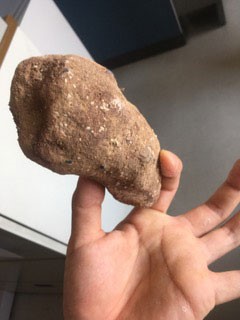
<アニメGIFへのリンク>
There are conspicuous large craters and hydrogenated minerals. When you look closely, you can see that among the relatively smooth terrain are scattered rocks that are several meters in size, making this a rough surface environment. Landing may be quite difficult.
Haya2-kun says...
Many people are imagining a round and dumpling-like Ryugu, but this one is more slender. As it is pretty irregular, it seems it could be difficult to land.
■28. Shota Kikuchi, responsible for astro-dynamics
(by Shota Kikuchi)-
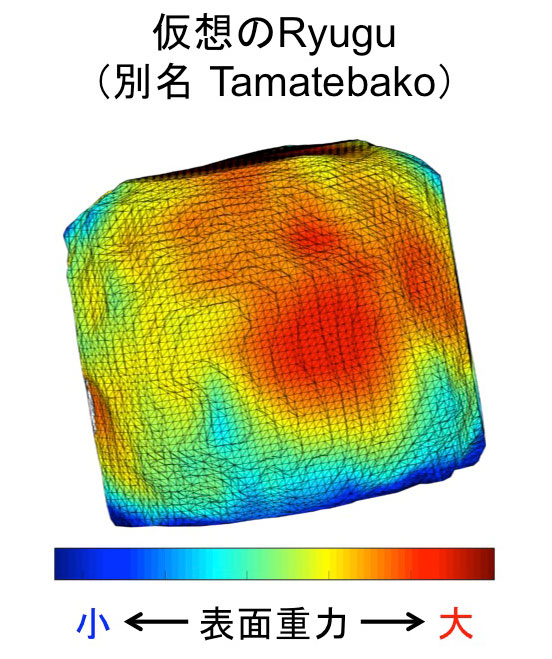
This asteroid has a cuboid shape that is reminiscent of the treasure box [jp: Tamatebako] in the legend of Urashima [where Ryugu gets its name]. This is also consistent with the prediction that Ryugu has a relatively well-ordered structure based on the light-curve observations of the asteroid from the ground. Contrary to its appearance, the asteroid has an uneven gravitational pull [indicated by the colors in the image], which is enough to make an engineer cry! Rumor has it that by the time Hayabusa2 finishes the mission and returns to Earth, the Project Members will become old because of fatigue like Urashima himself.
Haya2-kun says...
Oh, being able to predict gravity is truly astro-dynamics! But why is the gravity so uneven? I wonder if there is something special under the surface. The impactor could reveal this!
■29. Ryudo Tsukizaki, responsible for ion engines
(by Ryudo Tsukizaki)-
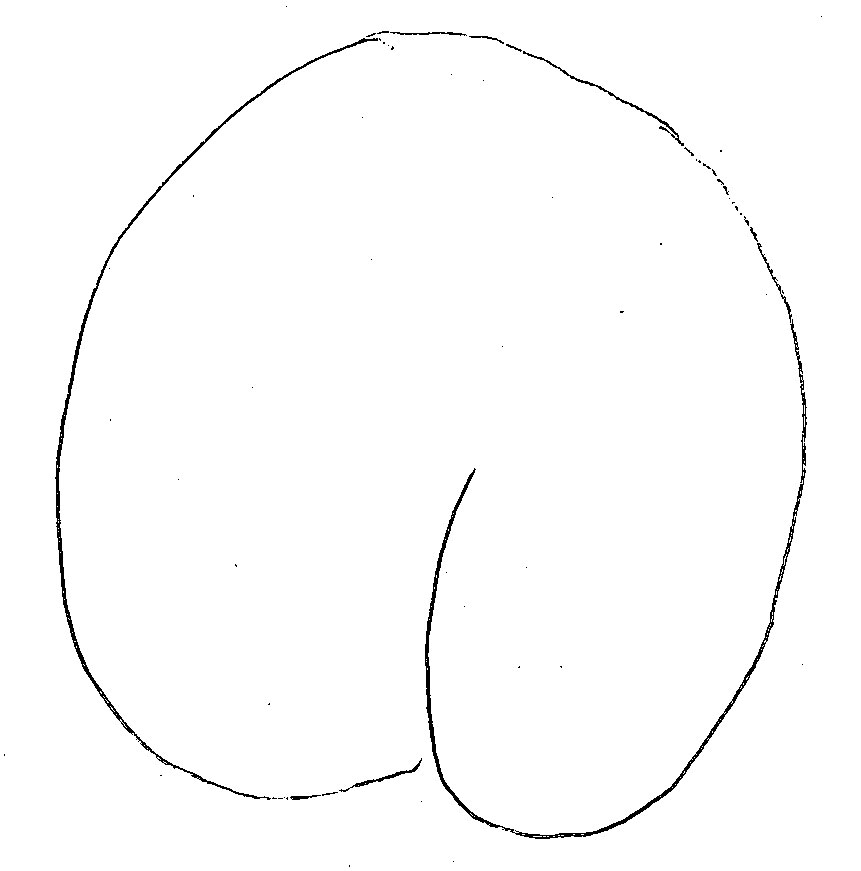
Peach-type asteroid! Two asteroids have collided and stuck together. We could get valuable data at the collision surface.
Haya2-kun says...
This is a super simple illustration! Itokawa is also thought to have been made by the collision of two asteroids. "Ryugu, is this true for you too?"
■30. Takato Morishita, responsible for SVS (Supervisor Support)
(by Takato Morishita)-
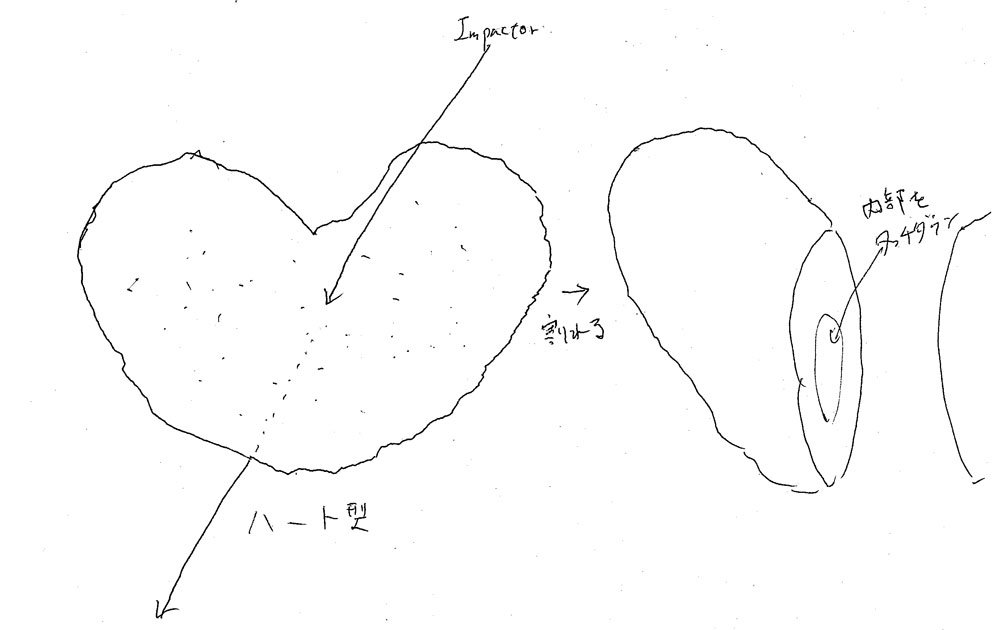
A heart-type is quite good but I do not want to destroy the heart with the impactor!
Haya2-kun says...
A heart-type is quite good but I do not want to destroy the heart with the impactor!
■31. Yukio Yamamoto, responsible for the data archive
(by Yukio Yamamoto)-
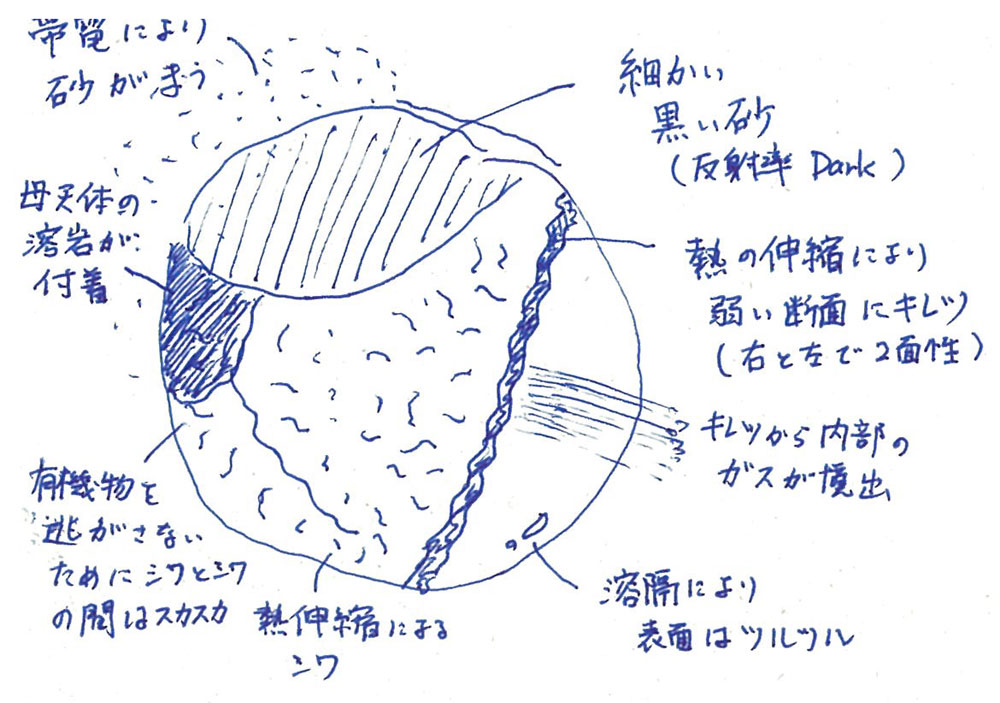
Everything in one huge bowl.
Haya2-kun says...
This is a very detailed prediction. I am at a loss as to where I should set down when there are so many different surfaces.
■32. Fuyoto Terui, responsible for the AOCS
(by Fuyuto Terui)-
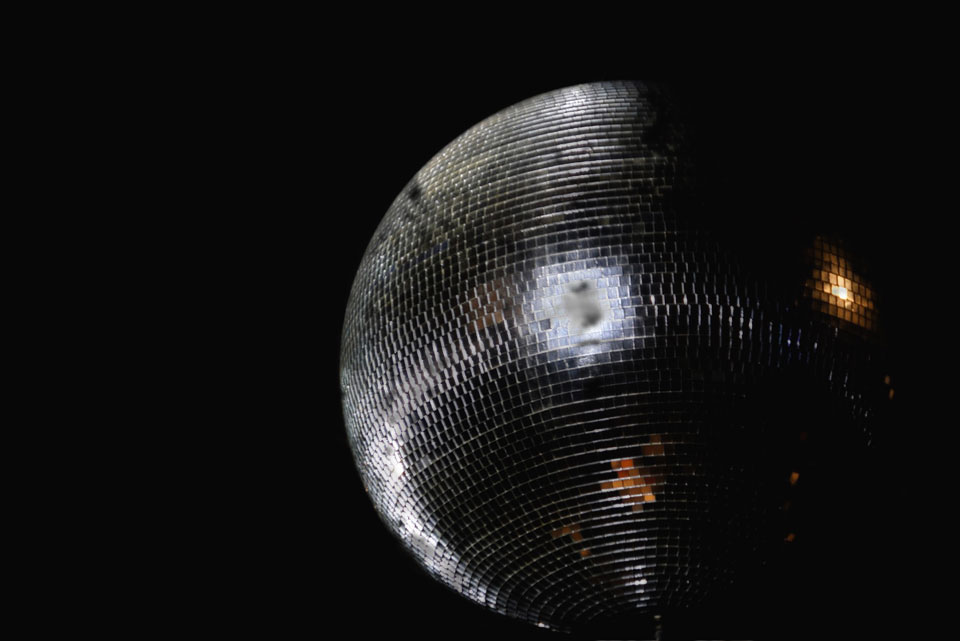
A Ryugu impossible for touch-down (a target marker mirror ball asteroid)
Haya2-kun says...
I cannot distinguish the target marker in this case... this is a new type of un-landable object! I'll have to close my eyes and land!
■33. Kazutaka Nishiyama, responsible for ion engines
(by Kazutaka Nishiyama)-
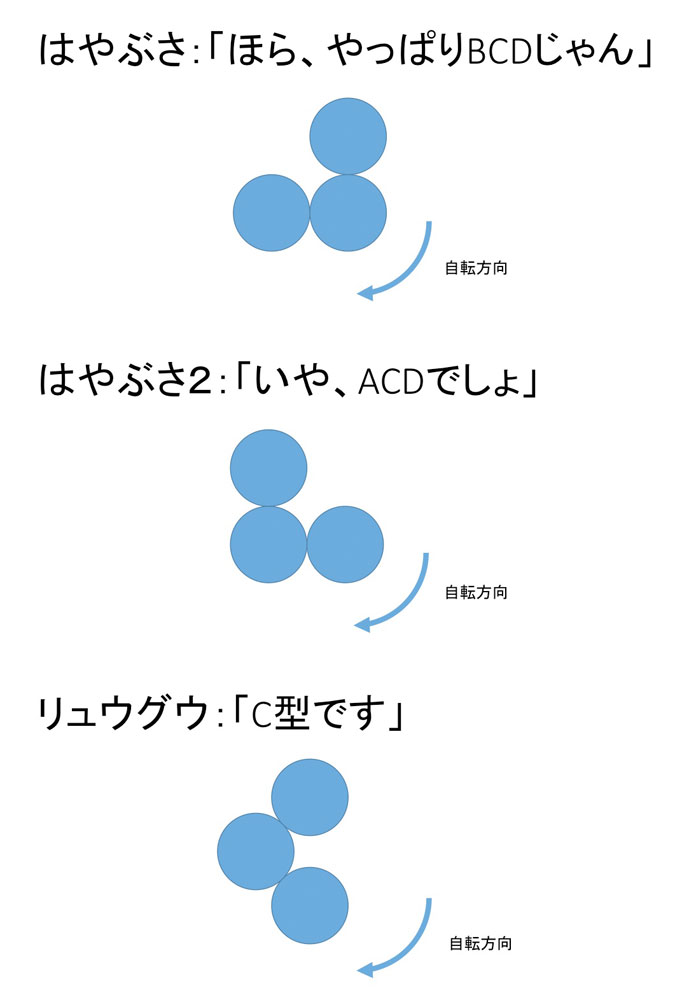
Hayabusa used ion engines B, C and D, while Hayabusa2 uses mainly A, C and D. B is a reserve and remains in brand new condition. Thanks to the experience with Hayabusa, we were able to complete the outbound journey without using the reserve.
Haya2-kun says...
Ah, this is the placement of the ion engines I used. As expected, from one responsible for the ion engines! If the images weren't rotated, would they all be the same...?
■34. Hirotaka Sawada, responsible for ONC, the sampler and DCAM3 (Detachable Camera)
(by Hirotaka Sawada)-
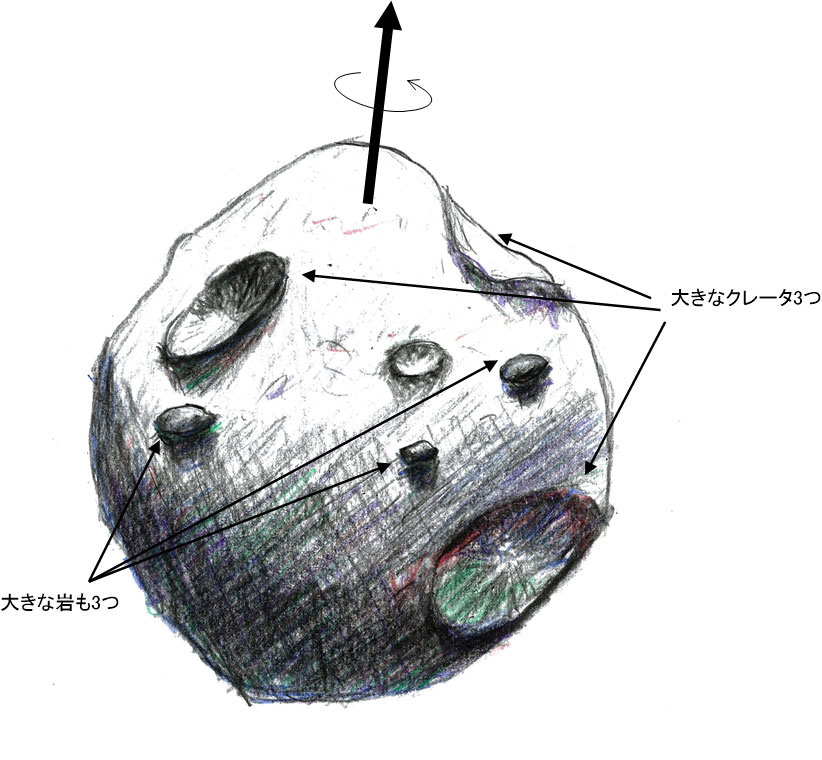
Where should we collect a sample?
Haya2-kun says...
Why are there both three big craters and rocks? It seems like there are a few places to land.
■35. Yasuhiro Yokota, in charge of the website
(by Yasuhiro Yokota)-
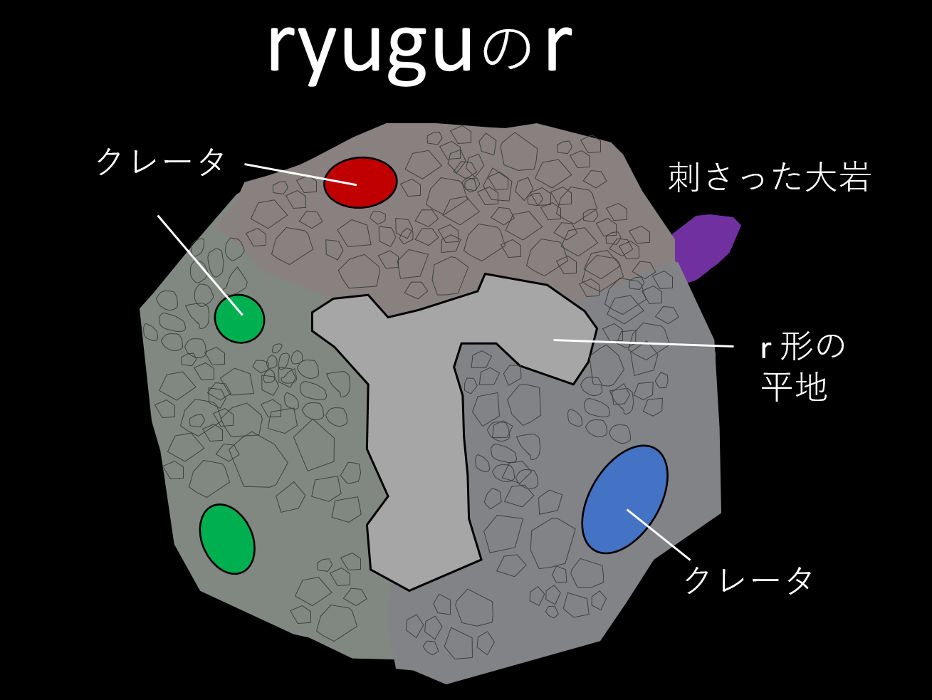
There is a large flat land in the shape of an "r". At first glance, the surface appears the same everywhere but you see more variety when you look inside the craters. The color represents the hope that we will see multiple geological features when observing at different wavelengths of light. In addition, it would be good to have a different kind of rock such as the protruding purple one.
Haya2-kun says...
It is funny to see Ryugu's r. Should I first land on this r-topography? I would like to land on a crater as well... How did that giant rock thorn get stuck?
■36. Assistant Noriko Tanaka
(by Noriko Tanaka)-
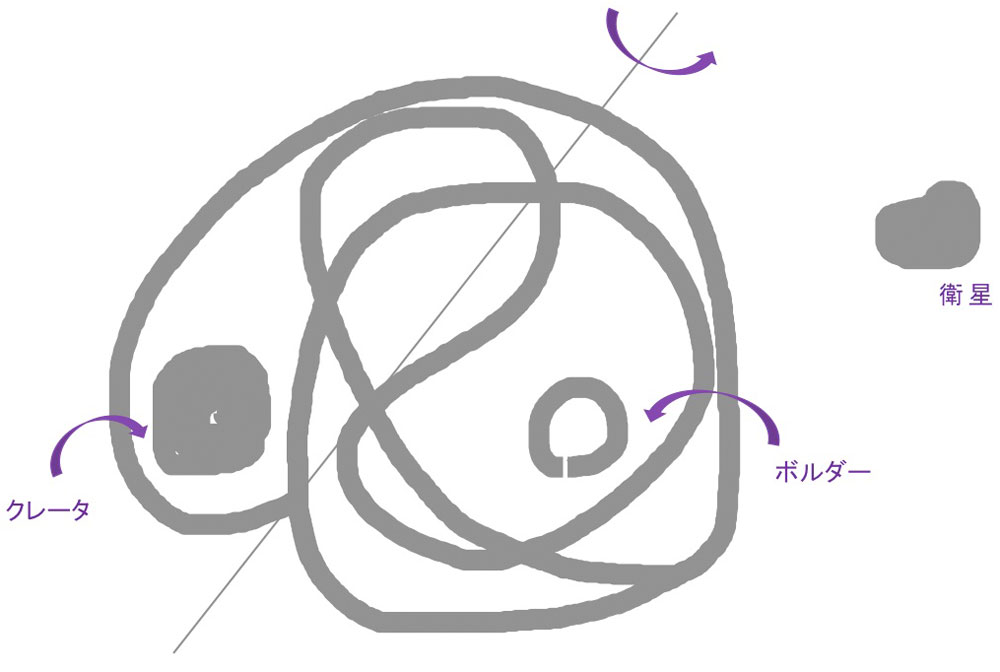
As the appearance finally becomes clear, I think this will be the shape of Ryugu. I hope it will look kind of familiar. I am praying it will be easy for Hayabusa2!
Haya2-kun says...
Ooh, that structure looks complicated and difficult... there also seems to be large satellites that might be possible to touch-down on.
■37. Makoto Yoshikawa, Mission Manager
(by Makoto Yoshikawa)-
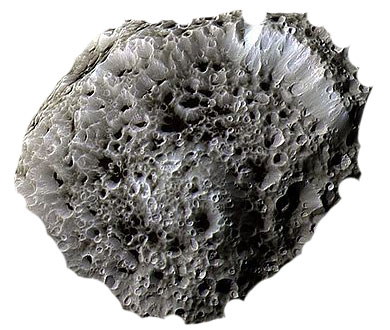
Another celestial body where it is impossible to land. So many holes! This picture was created from images of the Saturn moon, Hyperion, taken by NASA's Cassini spacecraft, but we will have trouble if Ryugu is a similar celestial body.
-
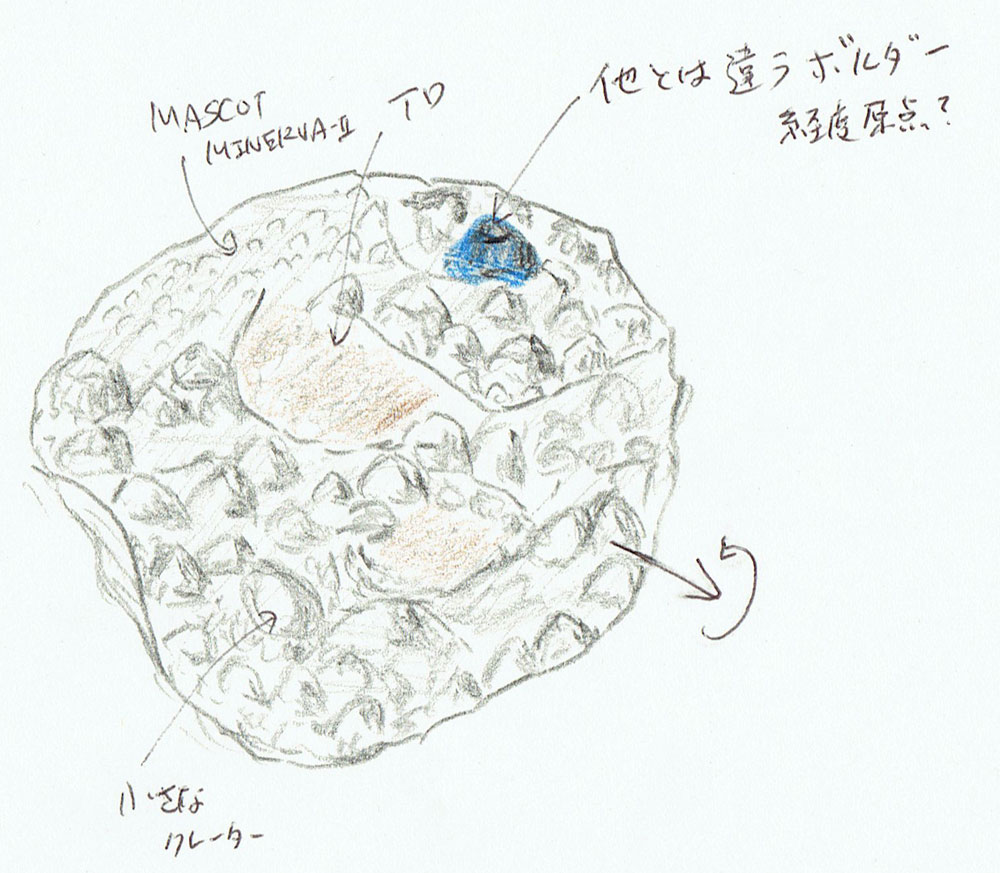
This is an imaginary diagram that seems probable. I have used Itokawa as an example. When Hayabusa arrived at Itokawa, I was surprised by the uneven appearance. The places where we can land may be limited as Ryugu is also probably covered in boulders.
Haya2-kun says...
We have seen a Ryugu like a sea urchin, but this seems more like a beehive. Landing will be extremely difficult. We don't need to worry about the landing on an imaginary map, but I have to get down there for real! Since the spin axis here is also tilted, there are less places I can reach to land.
And one bonus "Ryugu", added when the English translation was prepared.
■37. Elizabeth Tasker, responsible for global outreach
(by Elizabeth Tasker)-
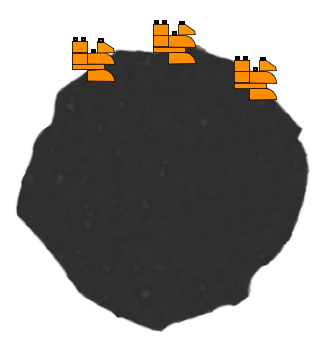
Sometimes auto-translators give very strange suggestions when converting Japanese into English. One translation said Hayabusa2 would be collecting “LEGO squirrels” from Ryugu. This was the translation of “レゴリス” (re-go-ri-su), a word written in the Japanese phonetic script that is usually used for words borrowed from foreign language. But “レゴ” also means “LEGO” in Japanese and “リス” means squirrel. However, the correct translation is actually “regolith”!
Haya2-kun says...
If I bring back LEGO squirrels from Ryugu, do they count as organic?
What did you think of the imaginary Ryugus from the professional creators and our Project Members? Project Members are imagining an asteroids that are extremely difficult to land on, and are worried about what this asteroid will be like! In any case, we will soon found out which Ryugu is close to the genuine asteroid.
Hayabusa2 Project
2018.06.05


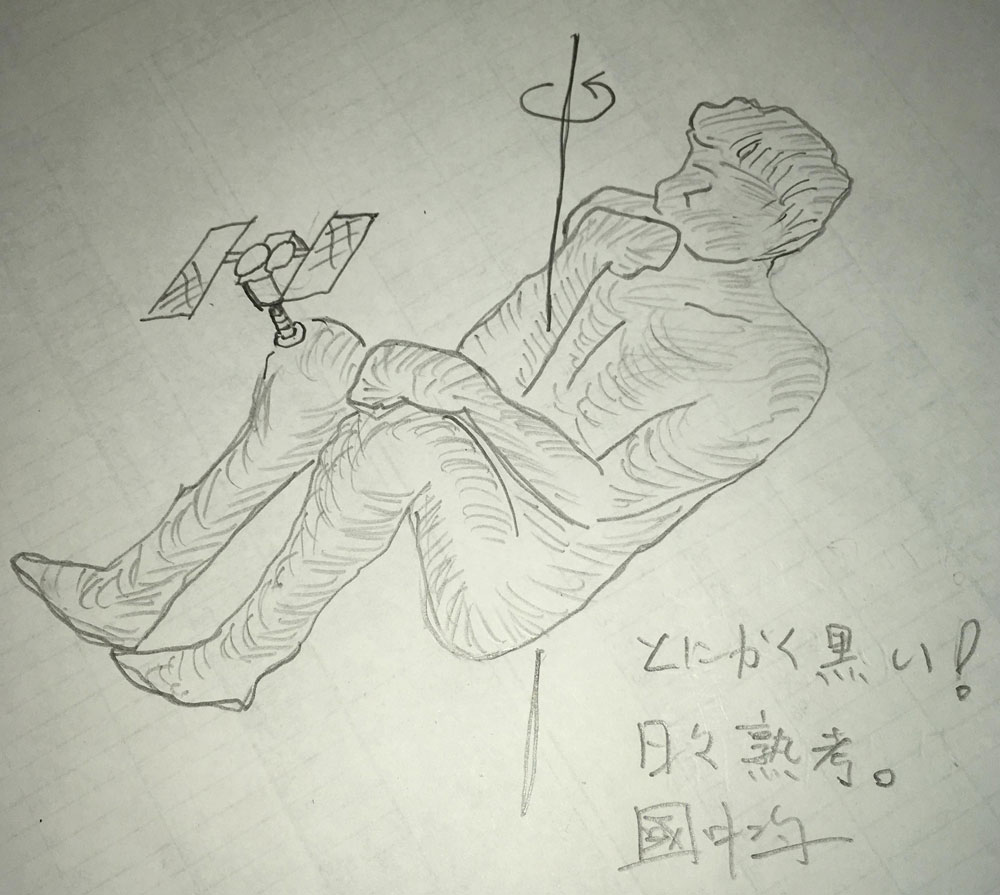 [Enlargement]
[Enlargement]